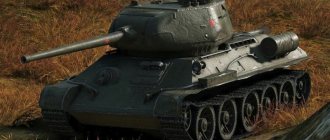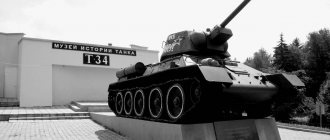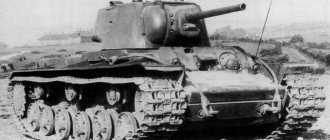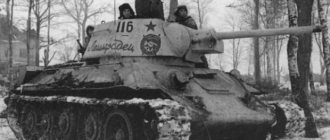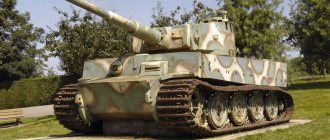T-34 versus "Panther"
In response to the increase in the production of Soviet tanks, the Germans doomed themselves to create many complex, but low-volume models of armored vehicles
A number of publications have already challenged one of the most tenacious judgments of Russian historiography - “The T-34 is the best tank of the Second World War.” However, I would like to warn against getting carried away by this “newly discovered truth.” We subconsciously strive for extremely simple explanations of the most complex phenomena of history, taking this simplicity as a function of truth. As a result, one simple scheme: “Soviet means better, that’s why they won” is replaced by another, no less simple: “Soviet is worse, but more numerous, they won in numbers.”
In this regard, I would like to add one significant aspect that allows us to look at the picture of the Soviet-German technical confrontation from a somewhat unexpected side and realize that the true content of this process is immeasurably more complex than the charming simplicity of our schemes. This is the mental warfare aspect of World War II.
MENTAL ATTITUDE
A tank, like any technical object, is a materialized concept that reflects the ideas of its authors about the functions of this object. Because of this, the mental aspect of a technical object is presented as a hierarchically structured set of its essential characteristics. And any technical object is the result of a compromise between mutually exclusive requirements. This means that the designer (customer) initially finds himself in a situation of choice when he determines what to sacrifice and what to give preference to: protection or mobility, or firepower...
It is at the moment of choice that the “mental attitude” is triggered, since the designer (customer) is guided by certain fundamental values - literally, what is good and what is bad, what is important and what is not, what is permissible and what is impossible. Moreover, as history shows, these compromises in the interpretation of different national design schools were strikingly different, which was a direct consequence of differences in national mental attitudes that determine basic values.
OVERWHEELING BUT USELESS SUPERIORITY
By 1941, the T-34 was the most advanced medium tank, embodying all the achievements of Soviet design thought and industry; its antagonist in the same “weight category” was the German medium tank Pz-IV. If we compare their characteristics, taking the performance of the Pz-IV as 100%, then by the beginning of the war the Soviet tank had an absolute superiority over the Pz-IV in protection - coefficient 219.3, a significant advantage in mobility - coefficient 136.1, significant in firepower - 121.4, and was absolutely inferior in terms of ease of operation for the crew and operation - coefficient 48.3.
If we supplement these data with a comparative analysis of the layout of the T-34 and Pz-IV, it will become clear how Soviet designers managed to achieve such a significant superiority over the enemy and what the price of this superiority was. The main advantage of the T-34 - in protection - was achieved through the use of increased (so-called rational) armor angles - up to 60 degrees in the frontal projection and 45 degrees in the lateral projection. But due to the inclination of the armor sheets inward, the armored volume of the hull and turret decreased. As a result, the 26-ton tank (manufactured in 1940, increased in weight to 28 tons in 1941) turned out to be cramped even for four crew members, and the crew of the German 20-ton Pz-IVD included five people!
In the cramped turret of the thirty-four there were only two people - the gun loader and the commander, who acted as a gunner. In real battle conditions, this distracted the commander from performing his main duties - controlling his own tank and subordinate unit - platoon, company, battalion. The installation of a powerful 76-mm F-34 cannon and a large diesel engine on the T-34 also absorbed the additional volume of the fighting compartment. The advantage in protecting the T-34 was also ensured by the small number of operational and working hatches - 5 versus 12 for the Pz-IVD. Each crew member of the German tank had his own hatch, while the Soviet tank had only two hatches for four. Needless to say, what this meant in battle conditions.
These shortcomings were aggravated by the low quality and design flaws of surveillance devices, which remained at the level of the early 1930s. The T-34 inherited all this from the tanks of the previous series BT-5 and BT-7. This little-known fact contradicts the point of view common in the literature, according to which the T-34 was conceived as a new generation tank. In fact, the T-34 arose as a result of a consistent and deep modernization of the BT-7. As a result, all the advantages of the T-34 in protection and firepower were “bought” at the cost of a colossal lag in operational characteristics, primarily in the comfort of the crew. Choosing between protection, firepower and convenience, Soviet designers, unlike their opponents, chose to sacrifice convenience.
The “Thirty-Four” was a kind of “people’s tank”; its concept reflected the mental attitudes of not only engineers, but also tankers. Surveillance devices, communications, and crew working conditions were not considered by either tankers or designers to be comparable in importance to firepower, protection and mobility.
Another combination of minuses and pluses inherent in the T-34 is the priority of simplicity and low cost of design to the detriment of the quality characteristics of the design as a whole. A characteristic feature of the T-34 layout, also inherited from the BT series, was the location of the engine and transmission installation in the rear of the vehicle. The Germans used a separate design in all their tanks - the engine in the rear, the transmission in front. The T-34 design had its advantages. The main thing is ease of installation and maintenance. The downside was the control drive system, running through the entire tank from the driver’s seat to the transmission, which greatly increased the force on the control levers and made shifting gears much more difficult. In the same way, the individual spring suspension system with large-diameter rollers used on the Soviet tank, being very simple and cheap to manufacture in comparison with the Pz-IV suspension, turned out to be large in placement and rigid in movement. The T-34 also inherited the suspension system from the BT series tanks. Simple and technologically advanced to manufacture, due to the large size of the rollers, which means the small number of support points per track (five instead of eight for the Pz-IV), and spring damping, it led to strong rocking of the vehicle in motion, which made shooting with it completely impossible. go. In addition, compared to a torsion bar suspension, it occupied 20% more volume.
Assessing the overall mental component of the T-34 design, we can say that its superiority in protection, mobility and firepower was achieved at the expense of convenience and efficiency. A direct consequence of this was the paradoxical situation at the beginning of the war, when the T-34, due to the overload of the commander, poor observation devices, and transmission deficiencies, could not realize its absolute superiority over enemy tanks. The conclusion about the overwhelming advantage of the T-34 was made by German generals only after four months of the war, although already in June-July 1941, numerous samples of new Soviet tanks were sent to Germany for research. Apparently, in the summer of 1941, German specialists were unable to appreciate the T-34 precisely because of the low level of technical excellence.
GERMAN REPLY
The immediate response to the “T-34 challenge” was the modernization of German tanks. And this answer very clearly revealed the mental features of solving the problem of increasing the efficiency of the tank as an object of national technical culture.
In the spring of 1942, the Pz-IV modifications “F” and “G” appeared in the Wehrmacht’s arsenal, which reflected the experience of clashes with Soviet tanks. German designers are radically increasing firepower by installing a new gun - KwK40 with a barrel length of 48 calibers (instead of the previous KwK37 gun with a barrel length of 24 calibers), which made it possible to increase armor penetration by 1.6 times. The armor is significantly increased - by 66% on the front of the hull and turret and by 50% on the side of the hull and turret. This was achieved by increasing the mass of the Pz-IV by 3.5 tons and slightly reducing mobility. But the main thing was still maintaining the previous working conditions of the crew. In other words, German designers, in order to increase firepower and protection, chose to sacrifice only mobility, but not convenience.
During the first year of the war, the T-34 also underwent modernization. The designers tried to eliminate the most glaring shortcomings of the machine. The transmission, air purifiers were improved, ammunition capacity was increased, etc. The most noticeable change in the design of the "thirty-four" was the development of a new turret. However, the reason for this was not the desire to improve the working conditions of the crew and finally make the turret three-seater, but the requirements of technology. The new tower was easier to manufacture - it could now be cast in machine-made molds, stamped using a powerful press and using automatic welding during assembly. In other words, the changes to the T-34 were dictated by a different priority than the Pz-IV - simplification and reduction in cost of production. The task of increasing or at least maintaining fire superiority over the modernized German tanks was not even set.
A comparison of the T-34 with the modernized Pz-IVG shows that the Soviet tank still retained its advantage in protection, but the superiority factor was reduced from 219.3 to 179.6. The relative mobility of the Soviet tank even increased - from 130.4 to 137.9, but the firepower ratio changed dramatically - from 121.4 it fell to 93.2. The improved Pz-IV caught up with the T-34 in effective fire combat range and already at a distance of 900–1000 m their shells pierced the frontal armor of the hull and turret of the Soviet tank. While retaining its advantage in crew comfort, primarily in observation and fire control devices, the modernized Pz-IV received a clear fire superiority over the T-34 at long combat distances.
As a result, by the spring of 1942, German designers, limiting themselves to very modest changes in the design of the Pz-IV, solved the “T-34 problem.” Modernized German tanks fought very successfully against Soviet thirty-fours.
IN THE CHASE OF ABSOLUTE SUPERIORITY
It would seem that the German command had every reason to direct its further efforts to expand the production of modernized tanks, thus consolidating the achieved superiority. However, in the summer of 1942, it was decided to begin creating new tanks Pz-V "Panther" and Pz-VI "Tiger". And the reasons for this were by no means of an operational-strategic or military-technical nature, since during this period the German troops achieved very impressive successes.
The appearance of the Tigers and Panthers was explained solely by the desire of the German leadership to restore the shaky technical superiority of German weapons. In the fall of 1941, this superiority was challenged by the successful actions of the Soviet “thirty-four”, and then the task was set to “again achieve technical superiority over the Russians.” The superiority of the T-34 was perceived by the Germans very painfully, as a kind of challenge, as something contrary to ideas about the features inherent in the German nation, its culture, including technical ones. In other words, the superiority of the T-34 was perceived precisely as a mental challenge.
A comparison of the characteristics of the T-34 and the Panther shows that with the advent of the new German tank, almost all the relative indicators of the thirty-four dropped sharply. Thus, firepower decreased from 93.2 (relative to the Pz-IVG) to 70.3, and the comfort of the Soviet crew from 52.7 to 39.4. Despite the fact that the Panther turned out to be very heavy and large (these figures for the T-34 are 20% less), the German designers managed to almost equal the T-34 in mobility. It’s hard to believe, but the almost 45-ton Pz-V was only 6% inferior in mobility to the 28-ton T-34. (Pz-IV was inferior to the “thirty-four” by almost 38%). Even the former advantage of the T-34 in defense was reduced to a minimum - to 111.4. The T-34 retained its advantage in armor over the Panther only due to the greater thickness of the armor in secondary areas - the roof, the side and rear of the turret, the side and bottom of the hull. At the same time, the Panther had double superiority in armoring the most dangerous areas - the front of the hull and turret.
Like the modernized Pz-IV, the Panther featured dramatically increased firepower. But, like the Pz-IV, this was achieved while maintaining the same caliber by increasing the barrel length to 70 calibers, which made it possible to increase the armor penetration of the new gun by 1.6 times. The Panther's 80 mm thick frontal plate was inclined at an angle of 55 degrees, which doubled its armor resistance. In a similar situation with the T-34, this led to a significant reduction in the internal volume of the tank and the forced placement of the driver's hatch in the front plate. However, in the case of the Pz-V, we have the exact opposite result - in terms of internal armored volume, it surpasses all Soviet and most German tanks. The secret is simple. German designers did not tilt the armor sheets inward, thereby reducing the reserved volume, but moved them outward (!), increasing the volume. The main disadvantages are a significant increase in the size and weight of the tank. In terms of weight - 45 tons, the Pz-V is far ahead of the T-34 (28.5 tons) and almost equals the Soviet “heavyweights” - KV (47.5 tons) and IS (46 tons).
As a result, the authors of the Panther project managed to radically increase protection, firepower, mobility, while improving the working conditions of the crew, sacrificing only an increase in size and weight. The appearance of the Pz-V "Panther" on the battlefield radically changed the balance of forces. The new German tank could hit the frontal armor of the T-34 already at a distance of 1500 m, while the “thirty-four” needed to get closer to a distance of less than 100 m to do this.
SOVIET COUNTERARGUMENT
The true qualities of the new German tanks were revealed in the most dramatic way in the summer of 1943 during the Battle of Kursk. Now the “Panthers” and “Tigers” were shooting at T-34s and KVs with impunity from unimaginable distances of 1.5–2 km for us, while themselves remaining invulnerable. Our generally recognized victory at the Kursk Bulge turned into severe losses for the Soviet tank forces. According to official data, 1,614 tanks and self-propelled guns were lost in the Kursk defensive operation out of 5,130 available at the beginning. Daily losses amounted to 85 vehicles. The ratio of losses on the battlefield was 1:3 in favor of the enemy.
And our response to this challenge also clearly revealed its mental component. The response to the appearance of the “Panther” was the T-34-85. The new "thirty-four" managed to catch up with the "Panther" in terms of firepower - coefficient 102.7; slightly improve the defense indicator - to 118.3; The working conditions of the T-34-85 crew were radically improved - to 83.7. And all this - with a slight decrease in mobility - to 103.5. How were such impressive results achieved?
Let us recall that the Germans, in an effort to radically increase the firepower of the Panther, armed it with a new, specially developed Kwk42 cannon, the same 75 mm caliber as the Pz-IV. Maintaining the previous caliber had a number of advantages - it was possible to avoid a significant increase in weight and dimensions, maintain the size of the ammunition load and rate of fire. The disadvantages of this option were limited fire maneuver due to the large - about 5 m - barrel length and increased manufacturing complexity. But the main thing is that during the war the Germans were forced to go to all the costs of creating and launching a completely new weapon into series.
Soviet designers chose a different path. The firepower of the new "thirty-four" was ensured by increasing the caliber of the gun - from 76 to 85 mm. At the same time, we, of course, lost all the advantages that maintaining the same caliber provided, but we gained in increasing armor penetration by 1.7 times compared to the T-34. Now the T-34’s gun penetrated the frontal armor of the Pz-V turret from a distance of 1000 m, and the side armor of the hull and turret from a distance of up to 2000 m.
But the main thing is different - the 85 mm anti-aircraft gun of the 1939 model was taken as the basis for the new S-53 tank gun, which significantly reduced the cost and accelerated the production of tank guns. In other words, Soviet designers did not “philosophize”, but took what suited the characteristics. And again, the main priority was simplicity, and therefore low cost, of the design. As a result of minimal changes in the design of the T-34 (an enlarged turret with a new gun), Soviet designers managed to minimize the advantages of the new German tank, thus finding a completely adequate response to the “Panther challenge”.
THE PRICE OF TECHNICAL EXCELLENCE
The structure of the German mental model strictly defined the only possibility of responding to the “Russian tank challenge” - achieving complete technical superiority. But the mental taboo, the need to maintain convenience (large reserved volume), left the only possibility for this - increasing mass and size. As a result, a fatal sequence arose: the necessary increase in protection and firepower while maintaining a large reserved volume invariably led to an increase in mass, and therefore to the need to create a new engine, a new suspension, transmission and, ultimately, a new tank. That is why during the war, starting in 1942, the Germans were forced to create a new generation of tank weapons. Each of these tanks was, in the full sense of the word, the latest example of German technology, embodying all its achievements. The new German tanks featured such innovations as an automatic transmission, a tank control drive using a steering wheel, a system for purging the gun barrel after firing, night vision devices, an automatic fire extinguishing system, etc.
The most significant disadvantage of this “response to a challenge” option was the significant increase in labor intensity and cost of the new tank. In terms of labor intensity, the Panther was almost twice as labor intensive as the Pz-IV. That is, instead of one Panther, two Pz-IVs could be produced. From the point of view of expediency and the cost-effectiveness criterion, such a response was an incredible luxury in conditions of total war. But the German leadership preferred this particular response to the Soviet “tank challenge”. Why? It seems that the main reason was the desire to demonstrate German technical superiority. Tanks were most suitable for this purpose. The demonstration was addressed to both the enemy and friendly soldiers, since demonstration as such is one of the powerful forms of moral influence.
In the initial period of the war, the successes of the Blitzkrieg spoke for themselves. But after its failure and the war entering a different phase - a long confrontation of potentials - such a need arose. The defeats of the winter of 1941 and especially 1942 undermined the Wehrmacht's faith in its superiority. The show of power was meant to restore it. In addition, the demonstration of technical superiority was supposed to break the enemy’s self-confidence. It was this argument that became decisive in approving the plan for Operation Citadel. Our mental model had other priorities, its own “sacred cow” - maintaining mass production, and therefore simplicity of design. This was Stalin's personal and very strict demand. That is why Soviet designers, while improving both medium and heavy tanks, always followed the path of choosing the simplest and cheapest options. All the shortcomings caused by the simplicity of the new models were made up for by the mass production of them. The strict demand of the State Defense Committee and Stalin personally to constantly increase the production of tanks forced us to reduce the cost of production in every possible way, constantly reducing labor costs. By the beginning of 1945, the labor intensity of manufacturing the T-34 decreased by 2.4 times compared to 1940, including the armored hull by 5 times and the diesel engine by 2.5 times. And this is in conditions when, without reducing the number of vehicles produced, a transition was made to the production of T-34-85 instead of T-34. It is not surprising that throughout the war, Soviet industry maintained absolute superiority in the number of tanks produced.
But the Soviet mental model had another significant advantage. The simplest improvement, for example, installing a new gun on the T-34, forced German designers to develop new modifications, which in complexity, and therefore in cost, were many times greater than the Soviet version. They doomed themselves to create machines that were obviously and incomparably more expensive and complex, and therefore scarce in number. During the war, 12 modifications of the Pz-III and 10 modifications of the Pz-IV, 4 of the Pz-V were put into service. Within the framework of such a model of response to the Soviet “tank challenge”, the Germans did not have a chance to even come close to the Soviet indicators of mass production of tanks.
In addition, the adoption of completely new and more complex types of tanks in extreme war conditions inevitably led to the fact that the vehicles turned out to be “raw”, with many “childhood diseases”, the elimination of which required significant time and effort. And finally, another direct consequence of the attempt of German designers to respond to the “T-34 challenge” within the framework of their own mental model. The sharp increase in the mass of new German tanks from 20–22 tons to 45–70 tons led to a sharp decrease in their operational and tactical mobility. So, for example, the range of the new German tanks turned out to be so small - for the "Tiger" on the highway 150 km, and 60 (!) km over rough terrain, for the "Panther" - 200 and 80 km, respectively, that it was prescribed in every possible way to limit their marches to their own move and use rail transport, which was very difficult.
Pz-V "Panther" and Pz-VI "Tiger", in fact, turned into anti-tank weapons (fighter tanks) in contrast to Pz-III and Pz-IV, which were strike weapons for maneuverable, offensive warfare. This feature of the new tanks was revealed during the Battle of Kursk. The frontal armor of the Panther was virtually invulnerable to fire from Soviet tanks and anti-tank artillery, while the side armor of the hull and turret was penetrated even by 45 mm gun shells.
In the summer of 1944, the inspector general of the Wehrmacht tank forces, Heinz Guderian, was forced to state: “The infantry divisions could not be provided with the necessary amount of anti-tank weapons, and the lack of them had to be compensated for by tanks. As a result, despite the monthly production of an average of 2,000 armored vehicles of all types, they were not used to perform their main task - conducting a decisive offensive." The continuing growth in the production of Soviet tanks only aggravated this consequence, forcing the German leadership to increasingly use tanks for anti-tank defense.
In other words, the response to the mental “T-34 challenge” within the German mental model led to the abandonment of the previous concept of using tanks. As a result, the German army lost its weapons, which brought it such impressive victories in 1939–1942.
M.D
In peaceful life, Dr. Franz Beke was a dentist. However, leisurely practice with a pretty red-haired nurse remained somewhere in another life. The whirlwinds of the history of the 20th century threw him into a cramped tank.
For several weeks now, Beke had been commanding a group of the 509th Tiger Battalion and the Panther Battalion (II/23 Pz.Rgt). As needed, this tank ram was reinforced with armored vehicles, motorized infantry and artillery.
Dr. Franz Beke
In mid-March 1944, the group became the core of a German counterattack from a major road junction - Proskurov (now the city of Khmelnitsky, Ukraine), to the west. The Wehrmacht's task was to prevent the tanks and infantry of the Red Army from bypassing the city.
At that time, Beke’s group, in addition to the “tigers” and “panthers,” included a tank regiment of the 1st TD, two battalions of assault guns, a reconnaissance battalion and motorized rifles of the 6th TD, and a division of artillery regiments of the 1st TD and 6th TD. However, the group consisted of no more than fifty tanks and self-propelled guns.
On the evening of March 17, Beke’s group established contact with the SS Lebstandarte 40 km west of Proskurov. Formally, the integrity of the front in this sector was thereby restored. Now marks about a new goal began to appear on the map - the village of Dzelinche. The group turned sharply to the north and northeast. The maximum task for the Germans was to regain control of the railway, which was key for the entire army group.
Attack from three sides
58th Guards a heavy tank regiment on an IS-85 approached Dzelinche when there was already smoke over the village from burning tanks and self-propelled guns. The regiment was taken to the rear for a short time to recover; the soldiers and commanders had time to rest and wash in the bathhouse. Early in the morning of March 18, five cars set out on a march towards the unknown.
By 15:30 on March 18, the regiment with four ISs saddled the Dzelinche - Bokievka highway. A new attack by Beke’s group followed at 15:40 from three directions at once.
This forced Soviet tankers to turn in the direction of one attack and expose their side to enemy tanks in another direction.
Having met a head-on attack along the highway from Bokievka, Soviet vehicles (including the fifth IS, which was in reserve) came under fire on the flank from the south of the village of Khomintsy. One tank was hit from a distance of 1,000 meters. But this turned out to be just a distraction. Turning towards Khomintsy, the ISs did not notice the third strike from the direction of the village of Tritelniki. German panzers that approached 600 meters set fire to all five vehicles at once.
By evening the Germans captured Dzelinche. At the end of the day, the report of the German III Corps assessed the resistance of the Soviet troops as “stubborn.” The 509th battalion of the Wehrmacht lost one Tiger irretrievably and four more damaged in the battles for Dzelinche. The II Battalion of the 23rd Tank Regiment lost at least five Panthers. At least eight Pz.IVs and six Sturmgeschüts from other parts of Beke’s group also went out of action.

